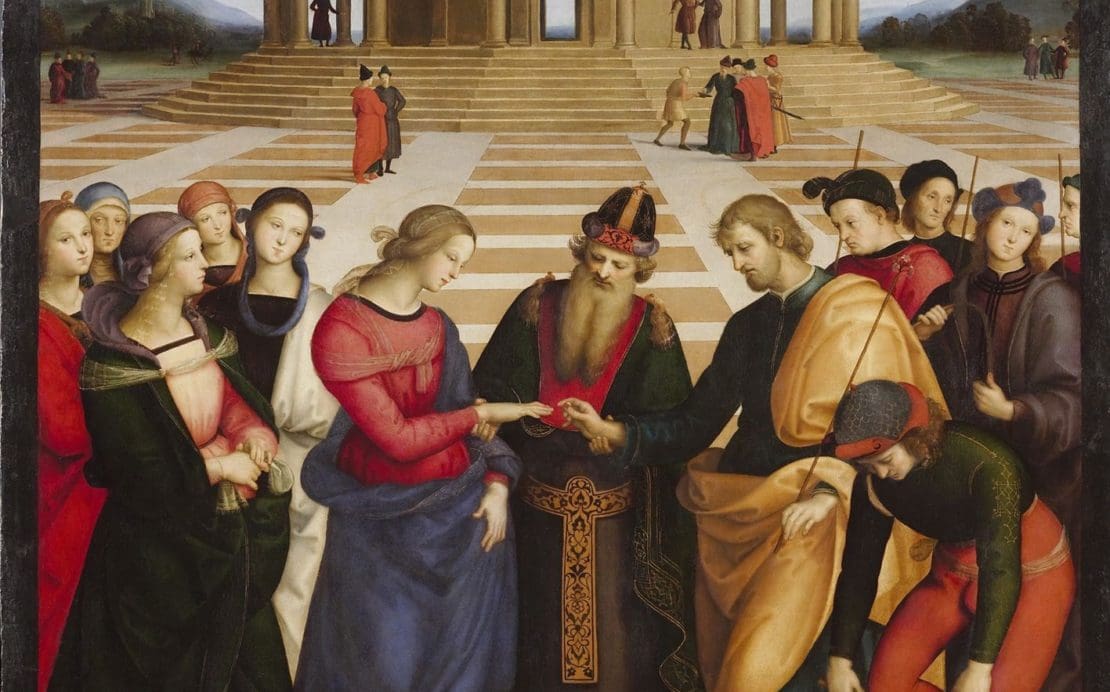Marriage: Covenantal and Graced Love
This is the eleventh of a series of posts outlining St. John Paul II’s thought on embodiment and sexuality. To read the preceding article, please click here.
In ‘Part One’ of the Theology of the Body, St. John Paul II establishes the spousal meaning of the body as the decisive foundation of personal existence for human beings, a meaning that is found in the body’s ‘power to express love… that love in which the human person becomes a gift and—through this gift—fulfills the very meaning of his being and existence.’ In the shorter ‘Part Two’, John Paul continues to develop the biblical conception of human embodiment and sexuality but now with a particular focus on the sacramental significance of the spousal meaning, a significance he examines from two closely related perspectives, that of marriage as a covenantal union that involves the bestowal of grace, and that of marriage as a sign of Christ’s love for the Church. In this and the next post, these interrelated perspectives will be presented in turn.
The Words of Promise: ‘I take you…’
The central words of the Catholic Rite of Marriage are as follows:
‘I take you as my wife/husband, and I promise to be faithful to you always, in joy and in sorrow, in sickness and in health, and to love you and honor you all the days of my life.’
This formula of marriage—one traditional for Catholic marriage and also found in some shape or form throughout all human societies and in all historical epochs—is in perfect accord with human nature, a nature decisively determined by sexual difference. With the words of the rite the couple mutually ‘express their readiness to become “one flesh” according to the eternal truth established in the mystery of creation.’ The words of the liturgical rite are incredibly important. The words signify what is taking place and also bring it about, precisely since the words effect what they signify. This means that through the words spoken by the couple, the covenant of marriage comes into being and a true spousal communion of persons is formed. In this way, the individual couple, in consenting to marriage, accept and embrace the divine plan for their lives, and God joins them in an exclusive and perpetual bond. Though it is the couple that promise their love to one another, it is God who does the joining of marriage, since, as Jesus explains, ‘what God has joined let not man put asunder’ (Mt. 19:6, Mk. 10:9). This means that God, the author of life and love, acts in and through the consent of the couple to join them as spouses in an indissoluble ‘one flesh’ union.
Another way of saying this is that from the moment the man and woman speak the words of consent, they truly become personal gifts ‘for’ each another—‘for’ the true good of one another, and ‘for’ the true good of the children they may receive from God. Having in this way realized their mutual gift of self with the help of the Lord, it is now in the spouses’ hands to freely respond to the essence of their union of which the vows of the marriage rite are only its first expression. The words of the rite of marriage correspond to the further expectation of the lived reality of the marital union. The lives of the man and woman’s now bear intimate reference to one another, which reference spans all the important areas of life and for all of life, and primarily in view of the children that may come forth from their union, ‘bone of their bones, flesh of their flesh.’ The spouses’ primary responsibility then becomes the giving of life to these words, so that the words which have instituted their ‘one flesh’ union be ever more fully incarnated in the daily lives of the spouses, together, and for their children, the first blessing of marriage. In this way, each individual marriage is bound to spiral deeper into loving communion, a love that begins in the ecstasy of self-giving love and progressively transitions toward a sacrificial form of self-giving love.
The Dimension of Covenant and Grace
Given this understanding of marriage, it is evident that marriage is fundamentally of the created natural order—even while it is something sacred within this natural order—and so, is something perfectly natural to the human being. Yet Christian marriage is also something that transcends the created natural order through the sacramental presence of the love of God to the spouses in and through their spousal relationship. Sacraments are visible signs of an invisible reality, the reality of divine love. Through the sacraments, the human person has privileged access to God and can, so to speak, sacramentally ‘touch’ God and be embraced by His all-encompassing love. Marriage is such a sacrament—a visible reality: spousal love, that signifies an invisible reality: the love of God. As such, marriage is intended to be a medium of communication of the love of God, making the love of God present to the couple in a tangible and experienceable way. Consequently, we can see that sacramental marriage is not merely an emergent feature of sexual difference and complementarity but is also and primarily something that is revelatory of the love of God. And so, Christian marriage is not merely a natural vocation and institution but is also a sacramental vocation and institution.
And, indeed, amongst all of the sacramentality of the created and redeemed world, marriage is of special significance precisely because it is a sacrament in two distinct but interrelated ways. First, through participating in the mystery of creation, and then through participating in the mystery of redemption. Both of these mysteries realize the love of God for the human creature, and in both of these mysteries, the ‘one flesh’ union of marriage plays a central role.
First, in terms of the mystery of creation: ‘In the beginning,’ from the first moment of the creation of the human person male and female, marriage signified the love of God in such a way that St. John Paul calls marriage a ‘primordial sacrament.’ Creation, as a gift of God, is a sign of the creative goodness and the love of God. The human person, as a bodily being, makes visible this invisible mystery of divine love. This making visible was due to the creation of the human person in the image of God and the further gracing of our first parents with an intimate participation in the divine life, a gracing that was even then in view of the human person’s ultimate election in Christ. Through the discovery of the spousal meaning of the body and their subsequent marriage, our first parents experienced the full depth of this creative gifting and gracing of God and rejoiced happily in His loving gaze. This means that already from the beginning, the mystery of divine love, a mystery to be fully accomplished only in Christ, was the guiding motif of creation, such that the loving relationship of our first parents already signified the love of God in Christ. And since marriage contains within itself the possibility of bringing new life into the world, the marriage of our first parents was intended to extend the creative love of God to all future human generations.
Now, though this primordial sacramentality of marriage was greatly maimed with the fall of our first parents through the loss of the inheritance of grace, marriage never failed to remain a sacred institution that represented an enduring figure of divine love, a union of self-giving love open to the generation of new life.
Then, in terms of the mystery of redemption: Marriage is a sacrament in a still more significant sense, precisely because Christian marriage also participates in the mystery of redemption. While bodily present among us, Jesus raised the created natural institution of marriage to the dignity of a sacrament of redemption, such that the institution of Christian marriage came to participate in this divine act of redemptive love. As such, a participation in redemption, the roots of sacramental marriage travel deeply into the mystery of redemption and draw life-giving grace from that very mystery. Therefore, since the coming of Christ, the sacramental marriage of Christians signifies the bestowal of grace, first, through the celebration of the rite of marriage itself, then, throughout the entire course of the married life of the spouses. Moreover, like the other six sacraments of the New Covenant, marriage is not a mere sign of the bestowal of grace, but rather is a ‘signum efficax gratiae, an efficacious sign of grace.’ This means that marriage is an effective cause of grace in the souls of the spouses, sanctifying the spouses and providing them with the divine help of the various actual graces needed for the spouses to fulfill their married vocation together, a vocation that is at once natural and supernatural. Now, and importantly, this sacramentality of marriage is not superadded to natural marriage, but rather represents the supernatural elevation of the covenant of marriage for Christian couples. Jesus Christ literally renewed (made new) the natural institution of marriage in such a way that when two baptized Christians validly consent to marriage, their foundationally natural union becomes, at one and the same time, a sacramental union. As so supernaturally elevated, the sacramental bond of marriage is the ever present source of grace in the lives of the Christian couple, a constant source of saving grace for everything that is required of them to live this self-sacrificial mode of life—a life ordered toward the procreation and education of their children, a life of mutual aid in service of one another, and a life that remedies (heals) the disorder of concupiscence. In this way, the bond of sacramental marriage is a sign of the abiding presence of God, helping the spouses to remain faithful to the continued fulfillment of their vows. And it is in precisely this way that marriage is a school of holiness, a school of love, and a school of human perfection.
In the next article, we will again reflect upon the sacramental character of marriage, but now with a focus on marriage understood as a sign of the spousal love of Christ and the Church. This further reflection deepens our understanding of marriage as a covenant of grace by highlighting its unparalleled relation to the mystery of Christ.
__________________
Notes: See John Paul II, Man and Woman He Created Them: A Theology of the Body, trans. by M. Waldstein (Boston: Pauline, 2006), §§. 15:1-4, 19:4, 22:3, 90:4, 92:6, 94:5, 95b:1-99:3, 101:1, 102:8, 103:1-7, esp. 15:1-4, 19:4, 90:4, 92:6, 94:5, 95b:1-99:3. The definition of the sacrament is taken from a footnote in §. 93:5 where St. John Paul discusses the historical development of the Church’s understanding of the sacraments and sacramentality. Compare Matthias Scheeben, ‘Christian Matrimony’ in Mysteries of Christianity, trans. Cyril Vollert (Herder, 2008), pp. 593-610.
Image: Lo Sposalizio (The Marriage of the Virgin), by Raphael, 1504, Pinacoteca di Brera, Milan.


